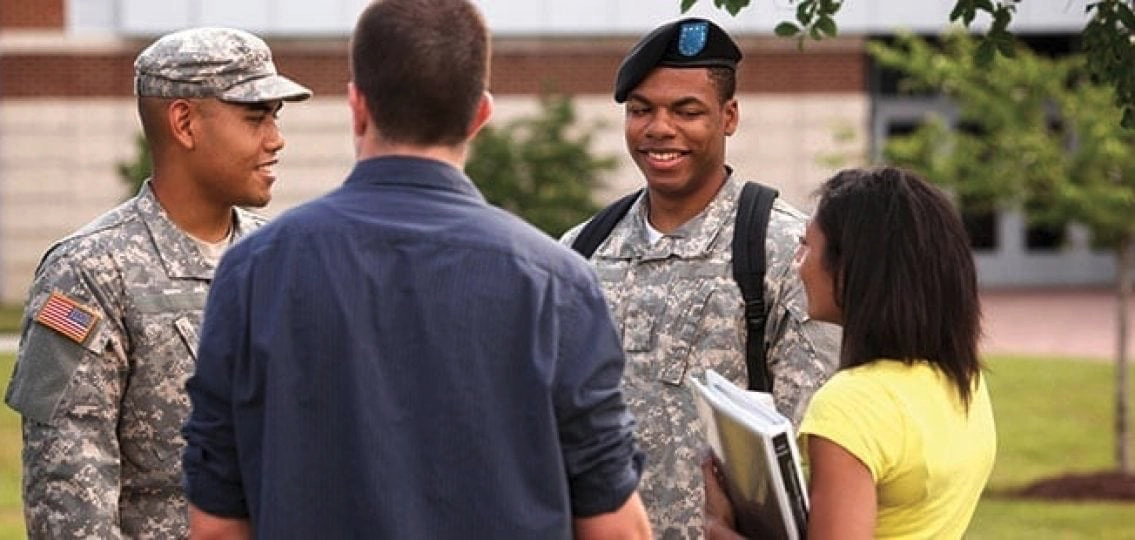The Military Is a Social Institution - Morten G. Ender | Sept 2022
The military is an invisible institution in undergraduate sociology.

The military is an invisible institution in undergraduate sociology (Ender & Gibson, 2005). For example, early sociologists, Lasswell (1941) and Sorokin (1937) accounted for the military. They studied wars, including World War II; the Cold War; Vietnam; the peacekeeping era; the Persian Gulf War; and later Iraq and Afghanistan. Both during and between wars, the military has remained a steadfast social institution in most societies around the globe. And like other social institutions such as education, religion, and the family, it has five structural elements (Henslin et al., 2014).
First, the military is an institution because it provides for basic needs—in this case, national security. It not only fights the nation’s wars but also engages with domestic and foreign humanitarian crises and disasters, counterterrorism and insurgencies, cyberwarfare, peacekeeping, and drug interdiction, among other actions.
Second, several groups and organizations constitute the military. The top five are the Army, Air Force, Navy, Coast Guard, and Marines. The United States suspended the draft in 1973, but selective service registration continues (Ender, 2021). Thus, uniformed members comprising the U.S. military are all volunteers, unlike many countries - such as South Korea, Morocco, and Sweden—which maintain some form of military service requirements, with nuanced exceptions. Within these armed forces are the National Guard, Reserves, and Department of Defense civilians, not including domestic and international contractors. In 2020, roughly 3.5 million people made up these groups (Department of Defense, 2020). Moreover, for the active duty and reserves, half of the enlisted members and almost three-quarters of officers are married, covering another 2,582,001 family members (i.e., spouses, children, and adult military dependents). According to the U.S. census, there are roughly 18 million veterans in the United States—meaning people who have ever served in uniform in the military. While fewer families in the United States include someone with direct military service, Americans are indirectly impacted by the armed forces through veteran work colleagues; tax expenditures for state and national defense; and moral, ethical, and humanitarian responsibilities as a population, both domestically and internationally.
Third, the military has cultural values. For example, the U.S. Army claims seven values: loyalty, duty, respect, selfless service, honor, integrity, and personal courage. West Point, the source of 25 percent of U.S. Army officers (the remainder come from ROTC and Officer Candidate School), adds the values of duty, honor, and country. The U.S. Air Force values integrity, service, and excellence. Some of these values mesh nicely with the larger society; others somewhat conflict with American values, such as selflessness versus individuality.
Fourth, the military has social roles. These roles are most distinguishable between enlisted members (85%) and officers (15%). The enlisted ranks have roughly 10–15 roles, from private to Sergeant Major/Master Chief of the service. The officers have 11 ranks, from second lieutenant to General/Admiral. Indeed, college undergraduates today rank military officers exceptionally high in occupational prestige (Genzmilitary, 2022), suggesting that military leaders have more esteem today than among previous generations. Other roles in the military institution include occupational titles, such as military police and combat engineer, and officer service branches, such as armor and military intelligence. Prisoners of war (POW), missing in action (MIA), combatants, and noncombatants are wartime roles.
Finally, the military has its own norms. Military norms include customs and courtesies, such as wearing a uniform, saluting officers outdoors, and removing hats indoors. They also include criminal laws, such as a law prohibiting adultery through the Uniformed Code of Military Justice (Hicks Stiehm, 2012).
Demographically, the U.S. military reflects the larger society but does not mirror it (Rohall, Ender, and Matthews, 2017). Under President Truman, the military began racial and sex/gender desegregation in the late 1940s. Today, the proportions of people of color serving in the military are comparable to their proportions in U.S. society at large, but percentages vary dramatically by job and rank. Women are roughly 25 percent of uniformed military and, as of 2015, are eligible for all military occupation specialties. LGBTQ+ uniformed members have always served, but LGB members could serve openly only as of 2011, and transgender uniformed members only since 2016. Young people and southerners are overrepresented in the military, and immigrants have long served in the military. People with specific disabilities cannot join, but those with disabilities acquired while in service may continue serving in some cases. Increasingly, the military is recruiting from within (soldiers making soldiers) and creating the potential for a military caste in America (Kleykamp, 2006). This is problematic because it would further alienate a society from its military.
Americans should know their military. Neglecting it as an institution ignores a significant and crucial piece of the American story. At the individual level, potential recruits and their families need to know what military service entails and implies. At the institution level, U.S. citizens need to understand and monitor the needs, groups/organization, values, roles, and norms of an institution that acts on their behalf. Finally, at the national level, it is vital that Americans elect civilian leaders that control and make informed decisions about the definition of defense in the twenty-first century.
Questions for Discussion
- Discuss the definition of national defense—from exclusively fighting the nation’s wars when attacked to other roles domestically and globally, such as peacekeeping; assisting NATO allies; cyberwarfare; redressing historic social inequalities; combatting extremist groups; space force; or immigration enforcement.
- How large should the military be? How different from the host society should a military be (e.g., demographics or values)? If the military does not reflect American society, who should serve?
- Should the U.S. return to military conscription? If so, should women be drafted? Parents? People with disabilities? Undocumented people? What form of mandatory service should the United States take? Discuss the social strengths and weaknesses of universal national service.
Carlton-Ford, Steve, and Morten G. Ender (eds.). 2010. The Routledge Handbook of War and Society: Iraq and Afghanistan (London & NY: Routledge).
Department of Defense, 2020. 2020 Demographics: Profile of the Military Community. Available online at: https://www.militaryonesource.mil/data-research-and-statistics/military-community-demographics/2020-demographics-profile/.
Ender, Morten. 2021. “What You Can Do For (Y)our Country,” New York Daily News, (October 12). Available online at: What you can do for your country – New York Daily News (nydailynews.com).
Ender, Morten G. 2017. “Tweets, Trans, and the American Military,” Just Security (August 7). Available online here: https://www.justsecurity.org/43912/tweets-trans-american-military/.
Ender, Morten G. 2009. American Soldiers in Iraq: McSoldiers or Innovative Professionals? N.Y. and London: Routledge.
Ender, Morten G., and Ariel Gibson. 2005. "Invisible Institution: The Military, War, and Peace in 1990s Introductory Sociology Textbooks." Journal of Political and Military Sociology, 33(2):249-266.
Genzmilitary. 2022. “From Doctors to Military Officers: Occupational Prestige Scores among Civilians and Cadets,” Genzmilitary.com. Available online here: https://genzmilitary.com/.
Henslin, James M., Adam M Possamai, Alphia L.Possamai-Inesedy, Tim Marjoribanks, and Katriona Elder. 2014. Sociology: A Down-to-Earth-Approach (11th edition). Frenchs Forest, Australia: Pearson, 81-83.
Hicks Stiehm, Judith. 2012. The U.S. Military: A Basic Introduction. London and NY: Routledge.
Homans, George C. 1946. “The Small Warship.” American Sociological Review, 11(3):294-300.
Janowitz, Morris. 1960. The Professional Soldier: A Social and Political Portrait. Glencoe, IIL, Free Press.
Kellner, Douglas. 1993. The Persian Gulf TV War. NY: Routledge.
Kleykamp, Meredith A. 2006. “College, Jobs, or the Military?: Enlistment During a Time of War,” Social Science Quarterly, 87(2): 272-290.
Lasswell, Harold D. 1941. “The Garrison State.” American Journal of Sociology, 46:455-468.
Mills, C. Wright. 1956. The Power Elite. NY: Oxford University Press.
Rohall, David E., Morten G. Ender, and Michael D. Matthews (eds.). 2017. Inclusion in the U.S. Military: A Force for Diversity. Lanham, MD: Lexington Books.
Segal, David R., and Mady Wechsler Segal (eds.). 1993. Peacekeepers and Their Wives: American Participation in the Multinational Force and Observers. Westport, CT: Praeger.
Sorokin, Pitirim A. 1937. Social and Cultural Dynamics. American Books.
Spencer, Herbert. 1883. The Principles of Sociology, II. NY: Appleton & Company.
Stouffer, Samuel A. et al. 1949-1950. The American Soldier (four volumes). Princeton, NJ: Princeton University Press.
Weber, Max. 1947. The Theory of Social and Economic Organization. Translated by A.M. Henderson and Talcott Parsons. Glencoe, IL: Free Press.



